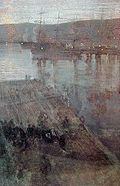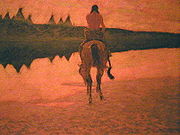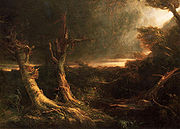.gif)
Nocturne (painting)
Encyclopedia


Visual arts
The visual arts are art forms that create works which are primarily visual in nature, such as ceramics, drawing, painting, sculpture, printmaking, design, crafts, and often modern visual arts and architecture...
, nocturne painting is a visual language
Visual language
A visual language is a system of communication using visual elements. Speech as a means of communication cannot strictly be separated from the whole of human communicative activity which includes the visual and the term 'language' in relation to vision is an extension of its use to describe the...
that is often used within realistic treatments (such as Realism
Realism (visual arts)
Realism in the visual arts is a style that depicts the actuality of what the eyes can see. The term is used in different senses in art history; it may mean the same as illusionism, the representation of subjects with visual mimesis or verisimilitude, or may mean an emphasis on the actuality of...
and Impressionism
Impressionism
Impressionism was a 19th-century art movement that originated with a group of Paris-based artists whose independent exhibitions brought them to prominence during the 1870s and 1880s...
) to depict scenes evocative of night or subjects as they appear in a veil of light, in twilight, or in the absence of direct light. Many artists develop their own methods
Methodology
Methodology is generally a guideline for solving a problem, with specificcomponents such as phases, tasks, methods, techniques and tools . It can be defined also as follows:...
to create nocturnes unique to their styles
Painting style
In the visual arts, style is a "...distinctive manner which permits the grouping of works into related categories." or "...any distinctive, and therefore recognizable, way in which an act is performed or an artifact made or ought to be performed and made." It refers to the visual appearance of a...
. The particular method or style that an artist chooses to paint a nocturne may not be limited to realism. Nocturnal depictions have also been shown within impressionist and abstract works
Abstract art
Abstract art uses a visual language of form, color and line to create a composition which may exist with a degree of independence from visual references in the world. Western art had been, from the Renaissance up to the middle of the 19th century, underpinned by the logic of perspective and an...
. Nocturnes are usually, but not always, inclusive of landscapes
Landscape art
Landscape art is a term that covers the depiction of natural scenery such as mountains, valleys, trees, rivers, and forests, and especially art where the main subject is a wide view, with its elements arranged into a coherent composition. In other works landscape backgrounds for figures can still...
and cover the gamut of artistic periods
Art periods
Art period n. A phase in the development of the work of an artist, groups of artists or art movement.-Renaissance:Renaissance c. 1300 - c. 1602...
, generally stretching from the southern and northern Baroque period of the early 17th century
Flemish Baroque painting
Flemish Baroque painting is the art produced in the Southern Netherlands between about 1585, when the Dutch Republic was split from the Habsburg Spain regions to the south by the recapturing of Antwerp by the Spanish, until about 1700, when Habsburg authority ended with the death of King Charles II...
to the present. Artists often use various methods to depict nocturnes: washes of color, impasto methods, and linear treatments.
Rembrandt’s nocturnes
In northern EuropeEurope
Europe is, by convention, one of the world's seven continents. Comprising the westernmost peninsula of Eurasia, Europe is generally 'divided' from Asia to its east by the watershed divides of the Ural and Caucasus Mountains, the Ural River, the Caspian and Black Seas, and the waterways connecting...
, the Dutch Golden Age
Dutch Golden Age
The Golden Age was a period in Dutch history, roughly spanning the 17th century, in which Dutch trade, science, military and art were among the most acclaimed in the world. The first half is characterised by the Eighty Years' War till 1648...
produced one of the greatest artists of all time. The first artist to paint scenes on a regular basis in the nocturne mode was Rembrandt van Rijn (1606–1669). Many of his portraits were also painted using a nocturne method. As in The Mill (1645), most of his landscapes were painted to evoke a sense of the nocturne, which could be expressed in either a calm or stormy manner. Among Rembrandt's other nocturnes are:
- Christ In The Storm On The Sea Of Galilee (1633) by Rembrandt van Rijn depicts a nocturne scene evoking a sense of danger
- Christ and the Woman of Samaria (1659)
- The Polish Rider (1655)
Gallery of nocturnes by James Abbott McNeill Whistler
“Nocturne” was a term that was normally applied to certain types of musical compositions before James Abbott McNeill Whistler (1834–1903), inspired by the language of musicNocturne
A nocturne is usually a musical composition that is inspired by, or evocative of, the night...
, began using the word within the titles of many of his works, such as Nocture in Blue and Silver (1871), in the collection of the Tate Gallery
Tate Gallery
The Tate is an institution that houses the United Kingdom's national collection of British Art, and International Modern and Contemporary Art...
, London, United Kingdom, and the following paintings that are pictured in order of date completed, left to right:


Nocturnes by American Realists
Nocturne scenes by well-known American RealistsAmerican realism
300px|thumb|[[Ashcan School]] artists & friends at [[John French Sloan]]'s Philadelphia Studio, 1898American realism was an early 20th century idea in art, music and literature that showed through these different types of work, reflections of the time period...
include:
- Spanish Dancer (1879–1880), by John Singer SargentJohn Singer SargentJohn Singer Sargent was an American artist, considered the "leading portrait painter of his generation" for his evocations of Edwardian era luxury. During his career, he created roughly 900 oil paintings and more than 2,000 watercolors, as well as countless sketches and charcoal drawings...
is an example of a figurative nocturne by an American Realist, The Hispanic Society of America, New York - Thomas Eakins (1844-1916)Thomas EakinsThomas Cowperthwait Eakins was an American realist painter, photographer, sculptor, and fine arts educator...
, Hiawatha (1870) - Robert Henri (1865-1929Robert HenriRobert Henri was an American painter and teacher. He was a leading figure of the Ashcan School in art.- Early life :...
, Snow in New York (1902), National Gallery of ArtNational Gallery of ArtThe National Gallery of Art and its Sculpture Garden is a national art museum, located on the National Mall between 3rd and 9th Streets at Constitution Avenue NW, in Washington, DC...
, Washington, D.C.Washington, D.C.Washington, D.C., formally the District of Columbia and commonly referred to as Washington, "the District", or simply D.C., is the capital of the United States. On July 16, 1790, the United States Congress approved the creation of a permanent national capital as permitted by the U.S. Constitution....
Nocturnes by American Impressionists
Nocturne scenes by imminent American ImpressionistsAmerican Impressionism
Impressionism, a style of painting characterized by loose brushwork and vivid colors, was practiced widely among American artists in the late 19th and early 20th centuries.-An emerging artistic style from Paris:...
include:
- Childe Hassam (1859-1935)Childe HassamFrederick Childe Hassam was a prolific American Impressionist painter, noted for his urban and coastal scenes. Along with Mary Cassatt and John Henry Twachtman, Hassam was instrumental in promulgating Impressionism to American collectors, dealers, and museums...
, Fifth Avenue Nocturne, (ca. 1895), The Cleveland Museum of Art, Ohio - Childe Hassam, Late Afternoon, New York, Winter (1900), Brooklyn Museum of Art
- Childe Hassam, Broadway and 42nd Street, (1902), Metropolitan Museum of Art, New York]
- Willard Metcalf (1858-1825)Willard MetcalfWillard Leroy Metcalf was an American artist born in Lowell, Massachusetts. He studied at the School of the Museum of Fine Arts, Boston, and later attended Académie Julian, Paris. After early figure-painting and illustration, he became prominent as a landscape painter...
, May Night (1906) - J. Alden Weir (1852-1919)J. Alden WeirJulian Alden Weir was an American impressionist painter and member of the Cos Cob Art Colony near Greenwich, Connecticut...
, The Bridge: Nocturne (Nocturne: Queensboro Bridge), (1910), Hirshhorn Museum and Sculpture Garden, Washington D.C. - J. Alden Weir, The Plaza: Nocturne, (1911), Hirshhorn Museum and Sculpture Garden, Washington D.C.
Frederic Remington’s nocturnes
Frederic Remington (1861-1909)Frederic Remington
Frederic Sackrider Remington was an American painter, illustrator, sculptor, and writer who specialized in depictions of the Old American West, specifically concentrating on the last quarter of the 19th century American West and images of cowboys, American Indians, and the U. S...
is so identified for his nocturne scenes of the American Old West
American Old West
The American Old West, or the Wild West, comprises the history, geography, people, lore, and cultural expression of life in the Western United States, most often referring to the latter half of the 19th century, between the American Civil War and the end of the century...
that they were celebrated in 2003-2004 with an exhibition, Frederic Remington: The Color of Night, co-organized and shown in turn by the National Gallery of Art
National Gallery of Art
The National Gallery of Art and its Sculpture Garden is a national art museum, located on the National Mall between 3rd and 9th Streets at Constitution Avenue NW, in Washington, DC...
, Washington, D.C.
Washington, D.C.
Washington, D.C., formally the District of Columbia and commonly referred to as Washington, "the District", or simply D.C., is the capital of the United States. On July 16, 1790, the United States Congress approved the creation of a permanent national capital as permitted by the U.S. Constitution....
, and the Gilcrease Museum
Gilcrease Museum
Gilcrease Museum is a museum located northwest of downtown Tulsa, Oklahoma. The museum now houses the world's largest, most comprehensive collection of art of the American West as well as a growing collection of art and artifacts from Central and South America...
, Tulsa, Oklahoma
Tulsa, Oklahoma
Tulsa is the second-largest city in the state of Oklahoma and 46th-largest city in the United States. With a population of 391,906 as of the 2010 census, it is the principal municipality of the Tulsa Metropolitan Area, a region with 937,478 residents in the MSA and 988,454 in the CSA. Tulsa's...
. The exhibition also generated a colorful book of the same title and travelled to the Denver Art Museum
Denver Art Museum
The Denver Art Museum is an art museum in Denver, Colorado located in Denver's Civic Center.It is known for its collection of American Indian art,and has a comprehensive collection numbering more than 68,000 works from across the world....
in Denver, Colorado
Denver, Colorado
The City and County of Denver is the capital and the most populous city of the U.S. state of Colorado. Denver is a consolidated city-county, located in the South Platte River Valley on the western edge of the High Plains just east of the Front Range of the Rocky Mountains...
. Remington painted many of his nocturnes in the last years of his life, when he was transitioning from a career as an illustrator
Illustrator
An Illustrator is a narrative artist who specializes in enhancing writing by providing a visual representation that corresponds to the content of the associated text...
to that of a fine artist and had chosen Impressionism
American Impressionism
Impressionism, a style of painting characterized by loose brushwork and vivid colors, was practiced widely among American artists in the late 19th and early 20th centuries.-An emerging artistic style from Paris:...
as the style in which he worked at the time. One example of his work is The Stampede (also known as The Stampede by Lightning, 1908).
Gallery of nocturnes by Frederic Remington
The paintings pictured in the gallery below are in order of date completed, left to right:Nocturnes by artists of other movements

- Jacob van Ruisdael (1628–1682), Landscape with Church (circa 1660)]
- Jacob van Ruisdael, Landscape (circa 1665)
- Thomas ColeThomas ColeThomas Cole was an English-born American artist. He is regarded as the founder of the Hudson River School, an American art movement that flourished in the mid-19th century...
(1801–1848), Moonlight (1833–34) - Thomas Cole, The Tornado (1835)
- Augustus Leopold Egg (1816–1863), Past and Present Number Three (circa 1853)]
- George Inness (1825-1894)George InnessGeorge Inness was an American landscape painter; born in Newburgh, New York; died at Bridge of Allan in Scotland. His work was influenced, in turn, by that of the old masters, the Hudson River school, the Barbizon school, and, finally, by the theology of Emanuel Swedenborg, whose spiritualism...
, Pool in the Woods (1892), Worcester Art Museum, Worcester, Massachusetts - John LaFarge (1835-1920)John LaFargeJohn La Farge was an American painter, muralist, stained glass window maker, decorator, and writer.-Biography:...
, The Lady of Shalott (1862) - Edgar DegasEdgar DegasEdgar Degas[p] , born Hilaire-Germain-Edgar De Gas, was a French artist famous for his work in painting, sculpture, printmaking and drawing. He is regarded as one of the founders of Impressionism although he rejected the term, and preferred to be called a realist...
(1834–1917), Interior (nicknamed The Rape) (1868–69), Philadelphia Museum of Art - John Henry Twachtman (1853-1902)John Henry TwachtmanJohn Henry Twachtman was an American painter best known for his impressionist landscapes, though his painting style varied widely through his career. Art historians consider Twachtman's style of American Impressionism to be among the more personal and experimental of his generation...
, Canal Venice (circa 1878), private collection - John Henry Twachtman (1853–1902), L'Etang (circa 1884), private collection
- Vincent van Gogh (1853-1890)Vincent van GoghVincent Willem van Gogh , and used Brabant dialect in his writing; it is therefore likely that he himself pronounced his name with a Brabant accent: , with a voiced V and palatalized G and gh. In France, where much of his work was produced, it is...
, Starry Night Over the RhoneStarry Night Over the RhoneStarry Night Over the Rhone is one of Vincent van Gogh's paintings of Arles at night; it was painted at a spot on the banks of river which was only a minute or two's walk from the Yellow House on the Place Lamartine which Van Gogh was renting at the time...
(1888) - Albert Pinkham RyderAlbert Pinkham RyderAlbert Pinkham Ryder was an American painter best known for his poetic and moody allegorical works and seascapes, as well as his eccentric personality...
(1847–1917), Death on a Pale Horse (The Race Track) (circa 1910), The Cleveland Museum of Art, Ohio - Frank Tenney Johnson (1874-1939)Frank Tenney JohnsonFrank Tenney Johnson was a painter of the american west, and he popularized a style of painting cowboys which became known as "The Johnson Moonlight Technique". Somewhere on the Range is an example of Johnson's moonlight technique...
, Rough Riding Rancheros (c. 1933)
Further reading
- Holden, Donald. Whistler: Landscapes and Seascapes. Lakewood, New Jersey: Watson-Guptill Publications, 1984.
- Anderson, Nancy with Alexander Nemerov and William Sharpe. Frederic Remington: The Color of Night. Washington, D.C.: National Gallery of Art, 2003.
- Sharpe, William C. New York Nocturne: The City After Dark In Literature, Painting, and Photography, 1850-1950. Princeton, New Jersey: Princeton University Press, 2008.
- Simpson, Marc and others. Like Breath on Glass: Whistler, Inness, and the Art of Painting Softly. Williamstown, Massachusetts: Sterling and Francine Clark Art Institute, 2008 (printed by Yale University Press).

